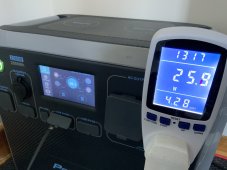lukerogers
New Member
- Joined
- Nov 23, 2021
- Messages
- 5
Hi, I recently purchased a PowerOak AC200P (UK model) and I’m experiencing some weirdness with the output at low wattages. I noticed that with low AC loads, the reported load is often much higher. I bought a wattmeter to verify the actual load on the device. For example, as you can see in the photo a 26W load is drawing 92W. Is this normal or expected? It seems better with higher loads, but this seems really inefficient at lower loads. The manual says it should be >88% efficient and even gives examples with a 20W LED lamp lasting 75-85 hours, which certainly couldn’t happen with the inefficiencies I’m seeing.
I used the wattmeter to measure the power drawn over an hour which should have equated to 2% battery loss, but I actually saw 5% battery loss, so it seems it’s not just a display issue.
I bought it on Amazon and have been in contact with PowerOak via Amazon. They’re fairly responsive, but I feel like I’m being taken for a ride. They’re dragging their heels and giving bogus answers. The latest was this:
Blaming the wattmeter seems like total BS to me. I only bought it because of the crazy numbers I was seeing in the first place! And why they’re bringing DC into this I don’t know, the DC seems fine.
I’m new to this, so I just wanted some reassurance that I can call them out on this. Also to say if you buy from PowerOak in the UK, don’t expect support to be helpful.
Thanks,
Luke

I used the wattmeter to measure the power drawn over an hour which should have equated to 2% battery loss, but I actually saw 5% battery loss, so it seems it’s not just a display issue.
I bought it on Amazon and have been in contact with PowerOak via Amazon. They’re fairly responsive, but I feel like I’m being taken for a ride. They’re dragging their heels and giving bogus answers. The latest was this:
Hi Luke, As we've consulted our technical staff, they suggested that the test results from a wattmeter is imprecise. As it can not calculate its power loss accurately considering its product conversion rate, line loss, standby power consumption, etc. By the way, we noticed that you plugged a device in a USB port, which is using DC output. And the AC load showed 92W is from the wattmeter. When plugging in the AC port with a wattmeter, the unit is also powering the device. Therefore, it's not accurate to test the unit with a wattmeter. Regards, Laura
Blaming the wattmeter seems like total BS to me. I only bought it because of the crazy numbers I was seeing in the first place! And why they’re bringing DC into this I don’t know, the DC seems fine.
I’m new to this, so I just wanted some reassurance that I can call them out on this. Also to say if you buy from PowerOak in the UK, don’t expect support to be helpful.
Thanks,
Luke



